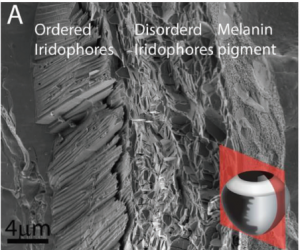The coloring of human eyes helps to prevent unfocussed light from reaching the retina. The melanin pigments that are present in the iris absorb a wide range of wavelengths, thus preventing unwanted light from reaching the receptors at the back of the eye. While many animals use this strategy for ensuring highly focused image processing, fish do things slightly differently.
Rather than absorbing the light that hits the eye around the lens, fish eyes reflect it. Not only does this prevent unwanted light from reaching the fish’s photoreceptors, it also camouflages the eye. To enable this, the light that is reflected from fish eyes must be reflected in very specific directions. While the dual function of fish irises has been long known, little work has been done to understand the mechanism that enables this. A team from Israel and Germany recently set out to remedy this situation using the zebra fish as a model.

The zebrafish eye at different stages of development.
The team used a variety of techniques to confirm that the iris of the zebrafish consists of three layers. The outermost layer is made up of ordered guanine crystals. These crystals reflect 90% of incoming blue-green light. Thanks to the extremely well regulated alignment of these crystals, light is reflected almost exclusively at an obtuse angle. This means that incoming light from the sun is reflected so that it continues travelling toward the bottom of the ocean. If the light were reflected back toward the surface, this would make zebrafish quite conspicuous and vulnerable to predation.

The three layers of the zebrafish iris.
The second layer is made up of the same guanine crystals, but here they are far less ordered. The team hypothesized that this layer works in conjunction with the third layer, a melanin rich region, to absorb as much of the light that makes it past the first layer as possible. The disordered crystals reflect the incoming light in all directions, increasing the likelihood that the melanin layer will absorb any light that hits it.
To align the guanine crystals between iris cells in as precise a degree as required for these mechanisms to work effectively is truly an impressive feat of bioengineering. The authors hope that a better understanding of these mechanisms may lead to improved construction of artificial photonic structures.

















